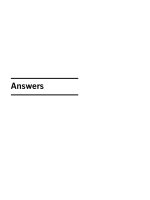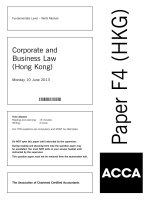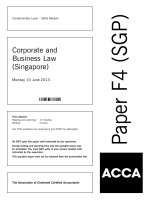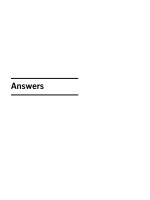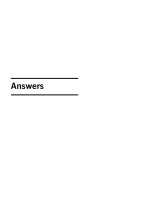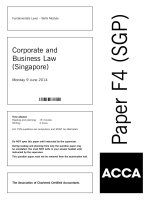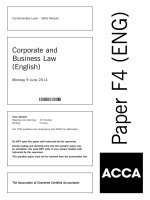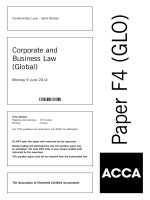ACCA f4 corporate and business law vietnam 2011 dec a
Bạn đang xem bản rút gọn của tài liệu. Xem và tải ngay bản đầy đủ của tài liệu tại đây (132.32 KB, 10 trang )
Answers
Fundamentals Level – Skills Module, Paper F4 (VNM)
Corporate and Business Law (Vietnam)
1
December 2011 Answers
The question asked candidates to explain the powers and duties of the National Assembly, and the powers and duties of the
President.
(a)
The powers and duties of the National Assembly are laid down in Article 84 of the Constitution.
The National Assembly is the supreme lawmaking body of the Socialist Republic of Vietnam. Its primary role is therefore to
develop and maintain the body of laws necessary for the functioning of the State and society as a whole. It creates new laws
and amends laws as necessary, including any changes to the Constitution.
The National Assembly elects key government officials and bodies such as the President, members of the Standing
Committee, the Prime Minister and the Chief Justice of the Supreme People’s Court. It may also suspend and revoke the
powers of these individuals and bodies.
The National Assembly decides on the structures of executive authority, including government ministries and departments. It
also decides the ranks in the armed forces, diplomatic service and other State bodies, and has the right to confer titles.
Building on its legislative role, the National Assembly, also exercises supervision of the observance of the Constitution and
laws. This involves examining reports by individuals and bodies with senior executive authority, including the President, the
Standing Committee, the government, the Supreme People’s Court and the People’s Inspectorate General.
The National Assembly is responsible for economic and social policy. Its duties in this respect include formulation of the
national development plan, implementation of monetary and fiscal policy and overall control of national and departmental
budgets.
Additional rights and duties include the formulation and implementation of foreign policies, the granting of amnesties,
declarations of war and peace, and the holding of referendums of the people.
(b)
The President is the head of State of the Socialist Republic of Vietnam, and in this capacity acts on behalf of the State in
domestic and foreign affairs.
The powers and duties of the President are laid down in Article 103 of the Constitution. Many of the duties are concerned
with putting forward recommendations to the National Assembly, or formalising the decisions of this body to bring them into
effect.
The President brings laws into effect by promulgating them on behalf of the people. He can also refer draft laws back to the
National Assembly for further consideration if he feels that the content should be reviewed.
The President makes recommendations to the National Assembly on the appointments of key individuals and bodies,
including the Vice President, the Prime Minister, the Deputy Prime Minister, the Chief Justice and the Chief Prosecutor. He
can also make recommendations on suspension and removal from office of these persons.
The President brings into effect the decisions of the National Assembly in respect of declarations of war, announcements of
emergencies, general and local mobilisations and amnesties.
The President is the commander of the armed forces and Chairman of the Council for National Defence and Security. He
grants senior ranks and titles within the armed forces.
2
This question tested the candidates’ knowledge of the law relating to offer and acceptance in the context of formation of legal
contracts.
The law relating to offer and acceptance, and civil contracts in general, is set out in s.7 of the Civil Code.
Article 390 states that an offer is a clear expression by one party of an intention to enter into a contract and be bound by the offer
made to a specific party. It therefore follows that not all representations by one party to another may be regarded as an offer. There
must be an intent to create a legal relationship on the part of both offeror and offeree. The recipient of the offer must be a specific
person or persons.
If the offer includes a time limit for a response, the time limit is effective from the point at which the offer is received by the offeree.
If the offeror enters into a contract with a third party before the time limit has expired, and this causes loss or damage to the original
offeree, the offeror may be liable to compensate losses or damage.
An offer is deemed to be received when it is delivered to the place of residence of the offeree, or in the case of a legal entity, when
it is delivered to the habitual place of business. An offer is also considered to be received if it is placed in the official information
system of the offeree.
An offer can be modified by the offeror before or at the same time that it is received by the offeree. It can also be modified if
conditions precedent set out in the offer materialise (Article 392). The modified offer then becomes a new offer. An offer may also
be rescinded if the right to do so is set out in the offer and this occurs before acceptance (Article 393).
Article 394 states the ways in which an offer may be terminated. This occurs if the offer is not accepted, if the time limit for
acceptance expires, when notice of modification is received, on rescission by the offeror or as agreed between the two parties.
7
Acceptance occurs when the offeree communicates acceptance of all of the conditions of the offer (Article 396). Partial acceptance
results in a counter-offer through which the offeree makes a new offer to the offeror (Article 395).
Late acceptance of an offer is regarded as a new offer, now made by the offeree. However, Article 397 states that if the acceptance
arrives late for objective reasons that the offeror knew about, or ought to have known about, the acceptance is effective unless the
offeror states immediately that this will not be the case.
Acceptance may be withdrawn if the notice of withdrawal reaches the offeror before or at the same time as the acceptance is
received (Article 400).
Article 398 states that once accepted a contract is formed, even if either party dies or loses civil capacity subsequent to acceptance.
3
The question asked candidates to explain the grounds on which an employee may be dismissed, and to describe the procedure
for dismissing an employee.
(a)
Article 84 of the Labour Code states that a person who is in serious breach of labour rules may be dealt with by reprimand,
by deferral of wage increases, by transfer to another position in the organisation, or by dismissal.
The grounds on which an employer may dismiss an employee are laid down in Article 85 of the Labour Code. These grounds
are additional to the conditions that may be mutually agreed in the labour contract between the two parties.
An employee may be dismissed if he or she commits a gross violation of duties or trust, such as theft, embezzlement,
disclosure of business or technological secrets, or any other conduct that is seriously detrimental to the assets or well being
of the organisation.
An employee may also be dismissed if he or she recommits an offence that is currently subject to disciplinary measures, such
as an extension of the period for wage increase, transfer to another position or demotion.
An employee may be dismissed if he or she takes more than five days off work in any one month or a total of 20 days off in
any one year without having proper reasons for doing so. These criteria apply to the aggregate time for which the employee
is absent and need not be consecutive days.
(b)
Articles 87 to 94 of the Labour Code set down procedures for dismissal of an employee. It should be noted that in addition
to setting out the due process for dismissal, Article 92 offers suspension of the employee as an interim measure.
If the organisation is considering the dismissal of an employee it must convene a disciplinary hearing. Notice of the hearing
must be delivered to the employee. If after three attempts to convene the hearing the employee fails to attend, the meeting
may proceed in the employee’s absence.
The disciplinary hearing is attended by the employer, the employee and a representative of the trade union if applicable.
Formal minutes must be taken of the hearing, and these must be signed by all parties present.
The burden of proof of the fault of the employee lies with the employer. If proven, the meeting can proceed to deciding on
disciplinary measures in keeping with the company’s internal rules.
If the employer and the trade union representative agree that dismissal is appropriate, the company can dismiss the employee.
It must then notify the relevant labour authority on the action taken.
If the employer and the trade union representative fail to agree on the dismissal, a report must be submitted to the Labour
Department. This suspends the right of the employer to dismiss the employee for 30 days, but after this period has expired
the dismissal may go ahead.
The decision to dismiss the employee may be appealed to the Labour Court by either the employee or the trade union.
The final decision of the employer must be communicated to the Labour Department within 10 days.
4
The purpose of this question was to test the candidates’ knowledge of the purposes and content of the Charter of a company, and
to set out the conditions of issuance of business registration certificates.
(a)
The Charter of a company is a formal statement of the characteristics of a company and the means through which its form,
structure and purposes are communicated to shareholders and other stakeholders in general.
Article 22 of the Law on Enterprises sets down 16 matters that must be set out in the Charter of a company. In addition to
these minimum requirements, a company may elect to include further information, provided this does not conflict with the
requirements of the law.
The Charter must contain the following information:
(1) Name of the company and addresses of the head office, branches and representative offices.
(2) Lines of business in which the company will be engaged.
(3) The Charter capital of the company, and the means through which this may be increased or reduced.
8
(4) Names, addresses nationality and other basic characteristics of the partners (in the case of partnerships) or founding
shareholders (in the case of companies).
(5) The number, value and classes of shares contributed by each founding member.
(6) The rights and obligations of members.
(7) The management and organisational structure of the enterprise.
(8) For limited liability companies and shareholding companies only, the name of the legal representative.
(9) Procedures for passing resolutions and resolving disputes.
(10) Bases and methods of calculating remuneration of managers and members of the inspection committee.
(11) Circumstances under which members may demand that their shares be redeemed.
(12) The rules for distributions of profits and for dealing with losses.
(13) Procedures for dissolution and liquidation of the enterprise.
(14) Procedures for making amendments to the Charter.
(15) Full names and signatures of founding partners or shareholders, or in the case of a shareholding company, its legal
representative.
(16) Other matters agreed by the members, provided these do not conflict with the law.
(b)
Article 24 of the Law on Enterprises lays down the conditions that must be satisfied for a business registration certificate to
be issued.
The registered lines of business of the enterprise as stated in the draft Charter must not fall within sectors in which business
is prohibited. These are set out in Article 11 of the Law on Enterprises.
The name of the enterprise must be compliant with the provisions of Articles 31 to 34 of the Law on Enterprises. These
Articles ensure that each company has a proper name from which the type of enterprise can be identified, forbids the use of
names that are identical or very similar to other enterprises, imposes conditions on the use of foreign names, and forbids the
adoption of names that will be confusing.
The location of the head office of the enterprise must be located within the sovereign territory of Vietnam and have a definite
address, pursuant to the provisions of Article 35(1).
The company’s business registration documents must be in order.
The business registration fee must be paid in full.
5
The question asked candidates to define the nature of an ordinary share, and to set out the rights and obligations of ordinary
shareholders.
(a)
An ordinary share is a transferable security that entitles the holder to make claims against the company in return for putting
up permanent risk capital. The claim is based on ownership rights, as the ordinary shareholders contribute equity and are as
such part owners of the company. The share also entitles the holder to a dividend when declared, based on the profitability
of the company and any other distributable funds, to information in respect of the company’s affairs and to participation in
decision-taking through general meetings of shareholders.
In subscribing for ordinary shares, the holder also enters into a commitment to put up capital for the company. This is the
maximum sum that the shareholder can lose in the event of the company ceasing to exist.
Article 78(1) states that all shareholding companies must have ordinary shares.
The rights and obligations of shareholders are set out in Chapter IV of the Law on Enterprises as well as any additional
requirements contained in the Charter of the company.
(b)
The rights of ordinary shareholders are set out in Article 79 of the Law on Enterprises.
Ordinary shareholders have a right to participate in general meetings of shareholders, and subject to minimum ownership
thresholds, may convene general meetings and decide the business to be heard by such meetings. They have the right to
vote, either directly or through a suitably authorised representative.
Dividends are decided by the general meeting upon the recommendation of the board of management. There is no automatic
right to a dividend, but shareholders are entitled to be treated equally with those holding the same class of shares.
To protect their stake in the company, ordinary shareholders have pre-emption rights through which they have priority in
subscribing to new shares issued by the company in proportion to their existing holdings.
Shares may be freely assigned to others, including non-shareholders, This right is restricted in the first three years of the
company having received a business registration certificate. Any assignment of shares within this period must be sanctioned
by the general meeting of shareholders.
9
Ordinary shareholders have a right of access to information in the list of shareholders and to demand that incorrect information
be corrected. They are also entitled to copies of the Charter, official minutes and resolutions of the company.
On dissolution of the company, the ordinary shareholders have a claim against the company for the nominal value of their
shares plus any other obligations that the company has failed to fulfil. However, Article 37 of the Law on Bankruptcy places
ordinary shareholders as the very last to be paid, after the claims of creditors and employees have been met.
Ordinary shareholders who own at least 10% of the share capital are entitled to nominate candidates for the board of
management and the inspection committee, and to refer to the minutes and resolutions of the board of management.
(c)
The obligations of ordinary shareholders are set out in Article 80 of the Law on Enterprises.
For newly formed companies, ordinary shareholders are compelled to pay for the shares for which they have subscribed within
90 days of the business registration certificate being issued.
All ordinary shareholders are liable for the debts and other property obligations of the company up to the total amount they
have subscribed.
Ordinary shareholders are not allowed to withdraw the capital they have subscribed except where the shares have been
redeemed by the company or other persons. If this requirement is violated, the members of the board of management and its
legal representative bear subsidiary responsibility up to the amount withdrawn.
Ordinary shareholders must comply with the provisions of the Charter and the internal rules of the company, and must
observe the resolutions of the general meeting of shareholders and the board of management.
Ordinary shareholders bear responsibility if they break the law, conduct business on behalf of themselves or third parties, or
pay premature debts when the company is exposed to financial damage.
6
The question asked candidates to explain the role, rights and duties of a general director, and to explain the conditions that must
be fulfilled in order for the individual to serve as a general director.
(a)
The role, rights and duties of the general director of a limited liability company are laid down in Article 70 of the Law on
Enterprises.
The general director is appointed by the Members’ Council of the company for a period not exceeding five years. The role of
the general director is to manage the day-to-day business operations of the company. The responsibilities of the general
director are dictated by the law and the decisions of the Members’ Council.
In managing the business operations of the company, the general director is responsible for the implementation of the
business plans and investment plans of the company, as determined by the Members’ Council. This involves implementing
resolutions of the Members’ Council and taking decisions relevant to the realisation of its plans. This managerial role also
involves issuing regulations on the internal management of the company.
The executive duties of the general director include the recruitment, appointment and dismissal of persons serving in
managerial positions, except for those positions that fall within the responsibility of the Members’ Council or the chairman of
the company. In this role, the general director also makes recommendations on the organisational structure of the company.
The general director has a role in managing the financial operations of the company to the extent that he or she is responsible
for submitting the final annual financial statements to the Members’ Council and makes recommendations for the
appropriation of profits or dealing with losses.
Further rights and obligations of the general director may be laid down in the Charter of the company or in the contract of
employment.
(b)
The conditions for appointment as a general director of a limited liability company are laid down in Article 70(3) of the Law
on Enterprises.
The general director must have full legal capacity for civil acts and not be prohibited by law from fulfilling such acts. General
prohibitions are laid down in Article 13(2) of the Law on Enterprises.
When an individual who is to serve on the board of management of a newly-formed company and is involved in the formation
of the company, Article 13 of the Law on Enerprises sets down certain general prohibitions. A general director may not be
related to the chairman or to a member of the Members’ Council, or to the person authorised to appoint the chairman or legal
representative of the company.
The general director must have relevant professional qualifications and experience in business management, or in the main
lines of business or other criteria or conditions stipulated in the Charter of the company.
10
7
The question asked candidates to explain how the undue debts and the undue debts secured by mortgage or pledge are treated
during the insolvency process. It also asked candidates to explain the consequences that arise from the insolvent company having
entered into a joint guarantee with a third party.
(a)
Undue debts owed by an insolvent company are governed by Articles 34 and 37 of the Law on Bankruptcy.
Article 34 does not distinguish between secured and unsecured debts. It states that once a judge has decided to commence
liquidation proceedings against a company, debts that are undue at the time of commencement of liquidation are treated in
the same manner as due debts. However, interest will not be calculated up to the due date.
Once the company is subject to liquidation proceedings, the Law on Bankruptcy has the effect of equalising the situation of
those to whom debts are owed and those who have future claims.
Article 37 of the Law on Bankruptcy states that debts will be paid in part or in full only after the claims of the liquidator and
unpaid wages, severance allowances and social insurance due in respect of employees have been paid in full.
(b)
Article 35 of the Law on Bankruptcy gives priority to those who are owed money under mortgage or pledge over other
claimants against the company. In effect, this means that the creditor may rely on the underlying security held.
It is important to note that this priority claim is against the asset pledged or mortgaged rather than against the general assets
of the company. Therefore, once realised, if the value of the underpinning asset is insufficient to meet the sum due to the
pledge or mortgagee, the priority is limited to the realisation value alone. If there is a pledge or mortgage shortfall, then the
shortfall remaining is treated as an unsecured debt.
Article 43 of the Law on Bankruptcy compromises the position of pledgees and mortgagees who have entered into contracts
with the company less than three months prior to the declaration of insolvency. In such cases, Article 44 empowers the court
to declare such transactions invalid.
(c)
In the event that an insolvent company has entered into a joint guarantee with others as an ancillary contract to a principal
debt, Article 39 of the Law of Bankruptcy enables the creditor to rely on the guarantees on a joint and several basis. In effect,
each party to the guarantee agreement is liable for the entire debt on the default of the principal debtor.
This does not in itself create a definite pecuniary obligation, as the rights under the guarantee are only realisable if the
principal debtor fails to discharge the obligation.
However, the practical effect of the insolvent company having entered into a guarantee is that there is a potential future claim
against the assets of the company. As by definition an insolvent company is unlikely to be able to discharge its debts in full,
this may weaken the position of the creditor.
8
The question tested the candidates’ ability to apply their knowledge of the law applicable to the validity of contracts entered into
by a company that has been adversely affected by external events.
(a)
The case study scenario describes a situation in which the management company representing a dancing act entered into a
contract, only to find that a subsequent movement in fuel prices caused its costs of transport to be increased. As this increase
in costs made the contract less attractive, the company sought to escape from the contract.
Article 389 of the Civil Code defines the essence of a contract as a form of bargain into which individuals and legal entities
can freely enter, based on equality, cooperation, honesty and good faith. A contract is formed once an offer has been accepted
in its entirety. Until then, each party is free to negotiate conditions that will define the rights and obligations created under
the contract.
It is customary for civil contracts to contain clauses that will protect the parties against unforeseen events. These so-called
force majeure clauses ensure that the liability of one party may be lessened or eliminated altogether on the occurrence of
specified events. In the case study scenario, an increase in fuel prices is the event that has caused Hai to seek an escape
from obligations under the contract.
Article 411 of the Civil Code specifies that a civil contract may be declared invalid due to impossibility of performance.
However, the increase in fuel prices and the consequent increase in the cost of travel do not make the contract impossible to
perform, even though such increases may severely compromise the financial outcome to Hai’s company. Article 411 seeks
to protect parties to civil contracts from events that are completely unforeseeable, but it is not intended to accommodate losses
suffered by failure to anticipate predictable risks that arise in the ordinary course of business.
As a result, Hai’s company would be in breach of contract by failing to perform, and could not use the increase in fuel prices
as a reason for rescinding the contract.
(b)
The second part of the scenario describes a situation in which a performance had to be cancelled at short notice due to
serious damage to the venue that had been booked for the performance.
Given that it would probably be impossible to arrange a new venue for the performance and notify all those who had
purchased tickets for the performance of this change, it is likely that the organiser would be able to rely on the provisions of
Article 411.
11
Article 411 refers to ‘impossibility of performance for objective reasons’. The intervention of serious damage to the
performance venue is an objective reason, as it is beyond the control of either party to the contract and could not be
reasonably foreseen by either.
The effect of Article 411 is that it invalidates the contract altogether. This means that the contract between Hai and the
customer is frustrated and will be regarded as not having been concluded.
Hai’s company has incurred transport and accommodation costs, which will now be lost due to the impossibility of
performance. Hai would not be able to make a claim for such costs, as the invalidation of the contract extinguishes all of its
provisions. This contrasts with a breach of contract, which would be remedied by a compensatory claim for losses, including
expenses incurred.
The only potential way of avoiding such an outcome would be to have included a force majeure clause in the contract,
anticipating cancellation for reasons beyond the control of the parties, and stating the outcomes that would arise should such
a situation arise.
9
The question asked candidates to demonstrate their understanding of the law relating to unlimited partnerships.
(a)
Thang is in breach of several obligations under the provisions of Articles 133 and 134 of the Law on Enterprises.
An unlimited liability partner is obliged to manage and conduct business activities honestly, diligently and in the best lawful
interests of the partnership. By pursuing personal business interests outside normal working hours and in using the resources
of the partnership to generate business of his own, Thang is in breach of the fundamental duty of honesty and serving the
lawful interests of the partnership.
An unlimited partner is also obliged to carry out business activities in accordance with the provisions of the agreement
between the partners. Although the scenario does not include details of the Charter or any other agreement between the
partners, these sources would certainly not envisage the right of partners to work on their own account for personal profit.
Article 134(2)(c) specifically forbids any unlimited partner from using the assets of the business for personal benefit.
Thang is also responsible for submitting information to the partnership on his business activities. Article 134(2)(g) states that
such reports should be at least monthly. In refusing to reveal his income and level of clandestine dealings, Thang has
breached this obligation.
Article 134 states that an unlimited liability partner shall not be allowed to conduct on its own name or in the name of another
person any activities in the same lines of business of the partnership for personal gain or to serve the interests of another
organisation or individual.
Chien could petition the court in respect of these breaches. In doing so, he would ask the court to compel Thang to deliver
up full details of his dealings and claim for the unlawful profits thus earned.
Article 138(3)(c) and (d) permit Chien to exclude Thang from the partnership due to these breaches. However, the
partnership cannot survive with just one partner, so exercising this right would terminate the partnership.
(b)
Chien wishes to replace Thang with Hien, a new partner.
In order to admit Hien to the existing partnership, this would require approval of the partnerhip council, which comprises
Chien and Thang. This course of action is inappropriate for two reasons. Firstly, assuming that Chien no longer wishes to
work with Thang, it would be unsatisfactory, even in the short-term, to expand the partnership in this way. Secondly, it is
unlikely that Thang would assent to this obviously transitional arrangement.
For reasons discussed in part (a), Chien cannot remove Thang as a partner, as the business must have at least two partners.
Therefore, it is not possible to remove Thang and then appoint Hien as a replacement partner.
Accordingly, the only way to structure the new business arrangement is to dissolve the existing partnership with Thang and
form a new partnership with Hien. Article 138 provides for termination of a partnership by voluntary withdrawal. Both
partners in the existing partnership bear responsibility for obligations arising from their business for a period of up to two years
from its dissolution.
10 The question asked candidates to analyse a scenario in which Linh, a potential new investor in a shareholding company proposed
conditions to be accepted by the company prior to funds being made available.
The company should advise Linh that some, but not all, of her demands could be addressed.
(i)
Equity stake of 25%:
The company may be able to meet this demand. As a company with freely traded securities, Linh’s demand for a 25% stake
could be met provided sufficient shares could be purchased from existing shareholders. Alternatively, the company could issue
new shares, but the existing shareholders would have pre-emption rights of purchasing these shares (Article 87(2), Law on
Enterprises), thereby precluding any guarantee that Linh would be able to obtain the desired level of ownership.
12
(ii)
Changes to the Charter:
The board of management would not be able to agree unilaterally to Linh’s demand that the Charter be changed to
accommodate new lines of business.
Changes to the Charter fall within the exclusive competence of the general meeting of shareholders (Article 96). Although the
board of management could recommend that the shareholders adopt such changes, there is no guarantee that they would
agree to this. The prospect of securing such agreement would be weakened by the existence of new business risks to a
company that is already experiencing difficulties.
(iii) Policies of the board of management:
Linh expects the board of management to agree to her preferred strategies and to accept her business decisions. Article 119
of the Law on Enterprises compels members of the board of management to exercise proper judgement in the best lawful
interests of the company. The duty of the members of the board of management is to the company and the shareholders as
a collective body. This implicitly excludes any right to act on the judgements of one individual.
(iv) Minimum dividend of 10%:
The company cannot guarantee a minimum dividend of 10% per year, as dividends must be funded from profit and other
distributable resources (Article 93, Law on Enterprises). Linh could receive a specified minimum return if the company was
prepared to offer preference shares, but this would be subject to the approval of the general meeting of shareholders. She
would also receive a guaranteed return on fixed interest bonds, subject to the company’s ability to pay, but these would not
give her the right to participate in the management of the company.
(v)
Guaranteed positions on the board of management:
The company could not guarantee Linh that she and her advisers would be guaranteed positions on the board of management
for ten years. The maximum term for which individuals can serve on the board of management is five years (Article 109, Law
on Enterprises), and in any event the shareholders have an unfettered right to remove an individual from the board of
management through a resolution of the general meeting of shareholders.
13
Fundamentals Level – Skills Module, Paper F4 (VNM)
Corporate and Business Law (Vietnam)
1
December 2011 Marking Scheme
(a)
Per power/duty of National Assembly
1 mark, max 6 marks
(6 marks)
(b)
Per power/duty of President
1 mark, max 4 marks
(4 marks)
(Total 10 marks)
2
Matters relating to offer
Matters relating to acceptance
1 mark, max 6 marks
1 mark, max 4 marks
(Total 10 marks)
3
(a)
Per ground for dismissal
Up to 2 marks, max 5 marks
(5 marks)
(b)
Disciplinary hearing
Outcomes of hearing
Reporting requirements
Up to 2 marks
Up to 2 marks
1 mark
(5 marks)
(Total 10 marks)
(a)
Per matter contained in Charter
1 mark, max 6 marks
(6 marks)
(b)
Per condition for issuance of certificate
1 mark, max 4 marks
(4 marks)
(Total 10 marks)
(a)
Nature of ordinary share
Up to 2 marks
(2 marks)
(b)
Per right of ordinary shareholder
1 mark, max 4 marks
(4 marks)
(c)
Per obligation of ordinary shareholder
1 mark, max 4 marks
(4 marks)
(Total 10 marks)
(a)
Role of general director
Per duty and right of general director
1 mark
1 mark, max 6 marks
(7 marks)
(b)
Per condition of appointment
1 mark, max 3 marks
(3 marks)
(Total 10 marks)
4
5
6
15
7
8
9
(a)
Provisions of Article 34
Provisions of Article 37
Effects on parties to the contract
1 mark
1 mark
1 mark
(3 marks)
(b)
Provisions of Article 35
Provisions of Article 43
Up to 2 marks
Up to 2 marks
(4 marks)
(c)
Provisions of Article 39
Joint and several nature of guarantee
Effects on parties to the contract
1 mark
1 mark
1 mark
(3 marks)
(Total 10 marks)
(a)
Analysis of scenario in relation to elements of contract
Application of law to the scenario
Up to 2 marks
Up to 3 marks
(5 marks)
(b)
Analysis of scenario in relation to elements of contract
Provisions of Article 411
Applications of law to the scenario
1 mark
Up to 2 marks
Up to 2 marks
(5 marks)
(Total 10 marks)
(a)
Breaches of partnership law identified from scenario
Consequences of unlawful acts
Up to 4 marks
Up to 2 marks
(6 marks)
(b)
Limitations on ability to change existing partnership
Removal of partner and admission of new partner
Requirement to form new partnership
Liability of partners after dissolution
1 mark
1 mark
1 mark
1 mark
(4 marks)
(Total 10 marks)
10 Minimum equity stake
Changes to the Charter
Right to decide policies
Minimum dividend
Guaranteed positions on the board of management
Up to 2 marks
Up to 2 marks
Up to 2 marks
Up to 2 marks
Up to 2 marks
(Total 10 marks)
16
